What Is a Convection Oven? Benefits, Types, and Cooking Tips
August 18th, 2021 | 9 min. read
By Saba Wahid
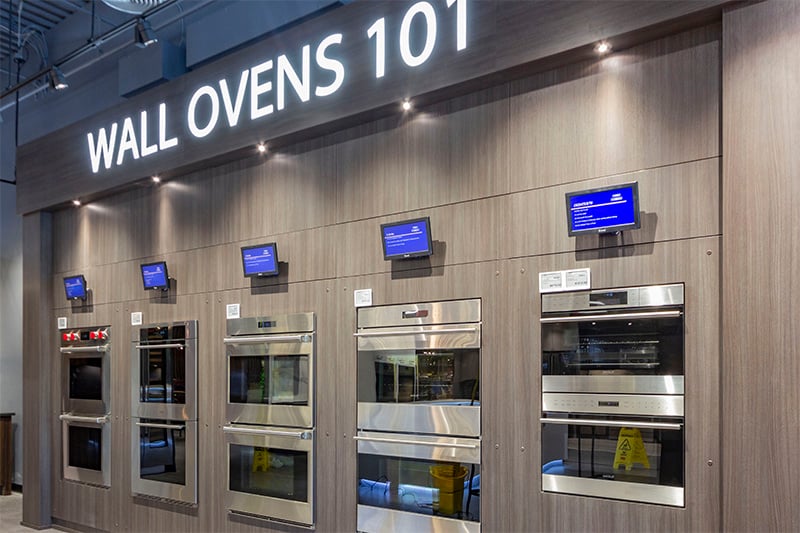
At a Glance
- What Is Convection?
- What Are the Best Types of Convection
Ovens? - How Do Different Types of Convection
Ovens Perform? - When to Use Convection
- What Are the Different Modes In Convection
Ovens? - What Should You Not Use Convection for?
- How to Use Convection Conversion Mode
on Your Range or Wall Oven - Should You Buy a Convection Oven?
If you've started considering a new oven purchase, chances are you will be faced with a choice to make, whether to go with a thermal oven or convection oven.
Thermal ovens offer standard oven modes like bake, broil, and roast.
Convection is fan-forced heat. However, you have brands with fan-assist, True or European Convection, and Dual Convection.
Now, Wolf has invented the VertiCross Convection system employing blowers instead of fans.
In this article, you will learn the several types of convection systems and their differences. Then we will look at when and how to use a convection oven effectively.
First, let's look at what a convection oven is and how it compares to a standard oven.
What Is a Convection Oven?
A convection oven uses a fan and a third heating element, which is placed in front of, behind, or wrapped around the fan, to evenly distribute the hot air in the oven for more even cooking.
In the most basic terms, the fan blows hot air onto the food to facilitate faster cooking and browning. At the same time, the forced hot air feels more intense, therefore producing faster results.
Convection ovens continuously circulate the heat to mitigate any hot or cold spots.
In addition to the fans, convection ovens have a bake element at the bottom of the oven and a broil element at the top of the oven, just like thermal ovens.
In a thermal oven, radiant heat is the primary heat source used to cook the food. The heat comes from one of two locations - the bake element at the bottom of the oven and then the broil element at the top.
Bake elements provide more BTUs or watts than a broil element, so naturally, there tends to be a higher concentration of heat toward the bottom of the oven.
The majority of this heat ascends from the bake element and moves up and surrounds the food to cook.
What Are the Best Types of Convection Ovens?
Single Convection
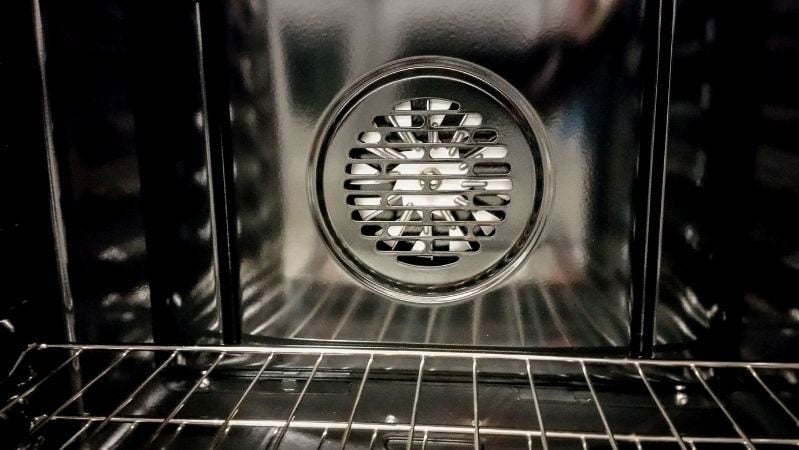
Single convection is exactly what it implies - an oven with just one fan in the back wall of the oven.
This fan does not have a heating element. The fan will assist the movement of the radiant heat throughout the oven cavity. Typically, this is the type of convection system that we see in all-gas ranges.
True/European Convection
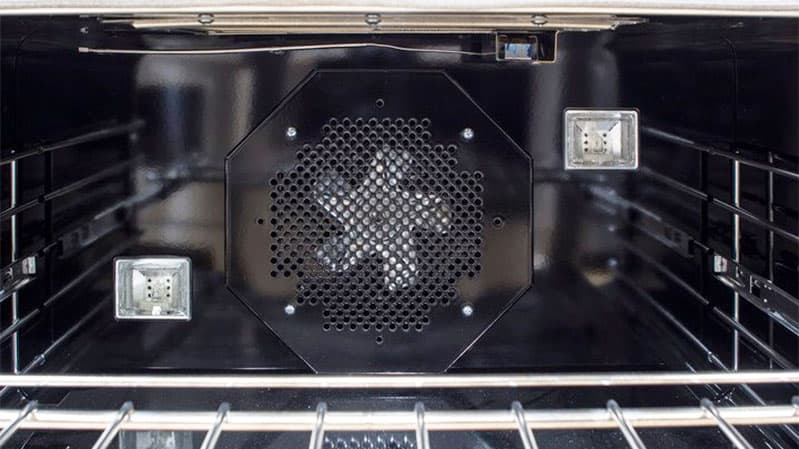
True convection and European convection are the same. True or European convection systems include a heating element wrapped around or placed behind the fan.
Using the True convection setting would imply using only the calrod heating element around the fan and the fan itself; no other heating element would be operating. True convection is found in electric or dual fuel ovens only.
Twin Convection
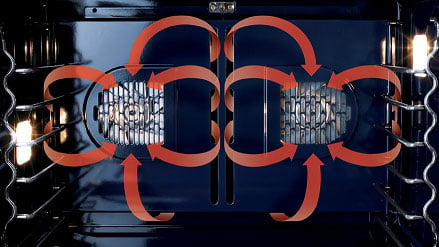
Twin Convection is a derivative of True Convection. The only difference is the addition of a second fan.
Most often, they are placed side-by-side horizontally. However, there are a few brands that offer vertical placement. From my experience, two fans don't always provide better performance.
You would think that two fans provide more power or a more controlled airflow. Sometimes their purpose is negated with the vertical convection fans. A second fan sometimes creates a cool wind channel in the middle rack.
Anything baking or cooking on the middle rack ends up lighter in color than the top and bottom racks.
The side-by-side convection system functions a little differently. Air circulates in all corners of the oven, from up and down, plus side to side.
The airflow is more even and consistent in this system, yielding more consistent results on all racks when multi-rack cooking.
VertiCross Convection
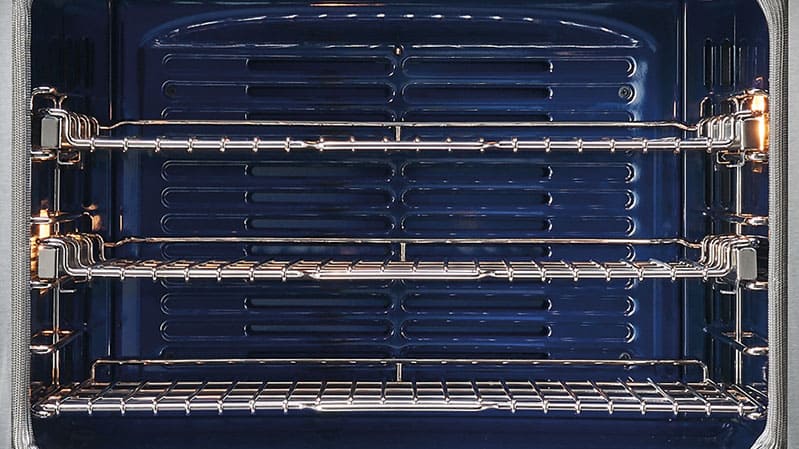
VertiCross convection is the newest convection system exclusive to the Wolf M-Series. The VertiCross convection system consists of two vertical blower fans located at the back corners of the oven.
Removing the fans from the traditional setting of the center back wall creates more usable space within your oven.
The columnar fans span from the top of the oven to the bottom, allowing total airflow front to back and side to side. The heating elements have also been reconfigured to run parallel with the fans creating that True convection system.
How Do Different Types of Convection Ovens Perform?
To answer this question, I tested three different convection systems, the Thermador single convection, Miele dual side-by-side, and the Wolf Verticross convection (M-Series) systems.
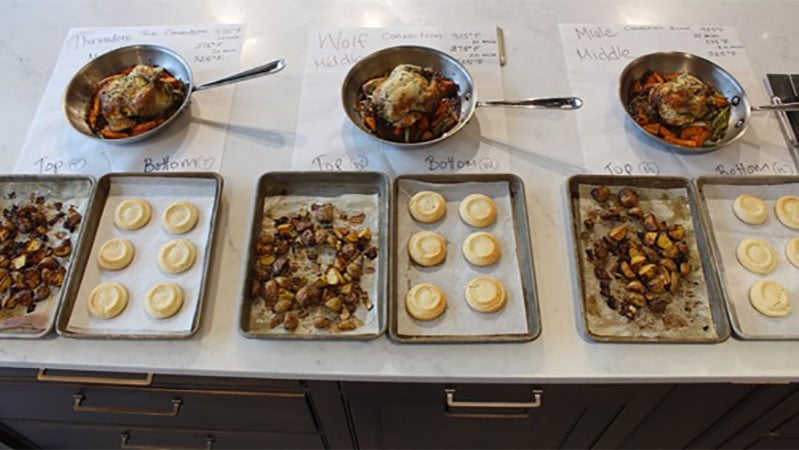
I made three items on the three oven racks in all three ovens at the same time. I started with Cornish Hens in the middle, followed by Yukon gold potatoes on the top rack, then sugar cookies on the bottom rack.
I started by cooking these in each oven on the center rack with a probe at Convection 425 F for the first 10 minutes. Then I dropped the temperature to Convection 375 F for the next 20 minutes, then Convection 325 F for the last 10 minutes.
In this scenario, the Cornish Hen roasted in the Miele oven achieved the best results. It had the most even overall brown color.
The potatoes were roasted on the top rack in each oven, simultaneously with the Cornish hens. They all got a significant amount of color.
However, the potatoes from the Thermador oven had the most color and texture.
Second to that was Miele, and last was Wolf. All three ovens produced satisfactory results, but the Miele was slightly better in terms of consistency.
As for the sugar cookies, they were all baked on the bottom rack for the last 12 minutes as the Cornish Hens and potatoes were finishing up.
The cookies from the Wolf VertiCross Convection got the most color on the bottom rack, followed by the Thermador, which was the most even, and last were the cookies from Miele, which were the lightest.
Thermador produces the best results for an item baked on the bottom rack while simultaneously cooking other items.
Miele Convection Oven Results
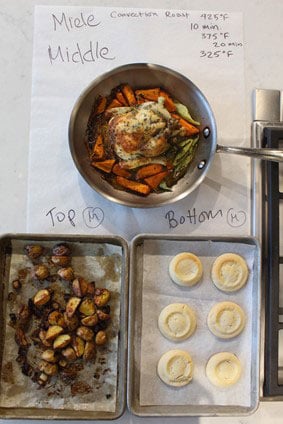
If I had to rank based on all of these results, I would give the Miele (M-Touch) side-by-side convection the top spot. The color from top to bottom was the most consistent.
The wireless probe is also handy because you don't have to plug it into a hot oven when cooking your proteins.
Miele also gives the most cooking modes and functions, along with an option to have the oven plumbed for a manual burst of steam while your food is cooking.
Thermador Convection Oven Results
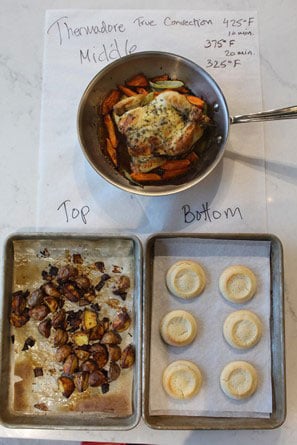
Thermador would have the second spot in this ranking order.
The True Convection mode gives an excellent blast of circulated heat in the oven, but it's not as consistent as the Miele.
Thermador is always my recommendation for those who lean more towards savory cooking, like roasts and vegetables, versus someone who does a mix of savory and pastry.
Wolf Convection Oven Results
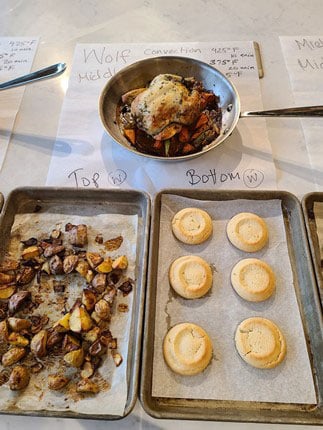
Wolf (M-Series) is coming in at third place.
The Cornish Hens that roasted on the middle rack got the least amount of color.
The potatoes on the top rack were cooked well, but the cookies on the bottom rack browned the most, giving this oven the most inconsistent results.
In Summary: It's difficult to rank three excellent quality appliances because everyone's cooking needs at home vary.
We are really splitting hairs when it comes down to the differences in the cooking results here because all did a satisfactory job.
It comes down to what you cook at home.
If roasting proteins and vegetables are more important to you, then the Thermador makes more sense out of the three.
The Miele is great for savory dishes and pastries. The Wolf M-series is slightly more delicate.
Additionally, some brands offer convection systems not tested here, like the Wolf E-Series single convection. In the past, that has proven to be more consistent in cooking tests over the M-Series VertiCross.
When to Use Convection
You can use the convection setting for cooking almost anything. Convection cooking is especially useful for multi-rack cooking and large roasts or dishes.
In the restaurant industry, convection ovens are most often the only ovens used because of their performance.
You may not notice a difference with one tray of cookies, but when there are three cookie pans in the oven, rest assured they will all come out even in color.
With large roasts, the differences will be reduced cook time, a crisper sear, and even browning.
What Are the Different Modes In Convection Ovens?
Convection ovens now have multiple convection modes you can use. Not every oven will have these modes, but they will certainly come in handy, especially for multi-rack cooking.
Below, we listed the different modes, where their heat source comes from, and how to use them.
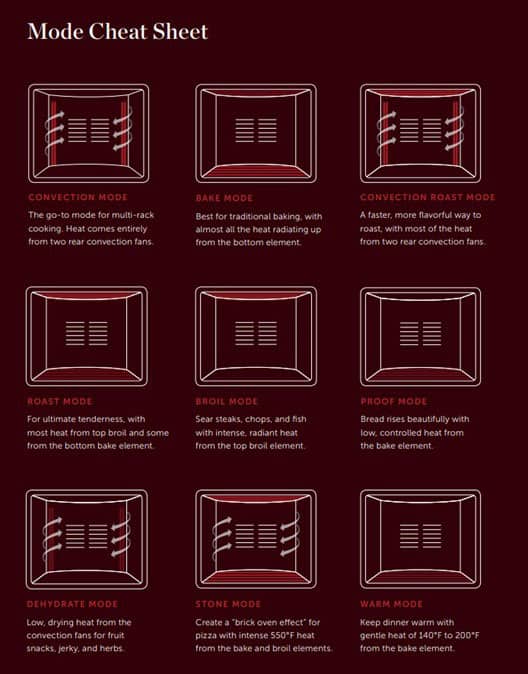
Convection Mode/True Convection/European Convection: This mode is ideal for multi-rack cooking. Heat comes entirely from rear convection fans and circulates evenly throughout the oven. This is ideal for everything from cookies and cupcakes to tenderloins.
Bake Mode: Bake Mode is best for traditional baking. This would be most com[rable to a standard thermal oven, with almost all the heat radiating up from the bottom element. This mode is recommended for quiches, custards, delicate soufflés, or angel food cakes that may require a more humid environment.
Convection Bake Mode: Heat in the cavity will come from the bottom heat element and the fans at the back of the oven. This mode would be great for anything you would want to get a nice crispy bottom for, like a pie or a pastry.
Convection Roast Mode: Heat will emanate from the top and back of the oven to give you a serious cooking intensity in the cavity. Meats and vegetables will fare well in this environment and produce the most depth of flavor in a shorter time.
Roast Mode: This mode is great for meats that need longer in the oven or for a braise to really tenderize. Most of the heat will come from the top and some from the bottom, and the food should typically stay covered, so it doesn't dry out.
Broil Mode: This is a pretty standard mode, which gives intense direct heat from the top of the oven. It’s great for searing steaks, chops, or fish. You can also crisp up chicken skin or melt cheese with this mode. You can also make toast on this mode. There are usually 2-3 different levels of heat depending on the brand.
Proof Mode: This mode provides a very low heat which allows yeast to thrive and helps the dough rise in half the time it would on your countertop.
Dehydration Mode: This mode utilizes the convection fans at extremely low temperatures for homemade fruit snacks, beef jerky, herbs, and more.
Stone Mode: This allows you to create a “brick oven effect” for pizza with intense 550 F heat from the bake and broil elements. Some ovens offer their own pizza stone and racks as add-on accessories. Alternatively, you can also use a regular pizza stone or inverted sheet tray.
Warm Mode: This mode will keep dinner warm with the gentle heat of 140 F to 200 F from the bake element on the bottom without drying it out. This is the perfect range for holding and serving food, preventing it from entering the temperature danger zone.
In Summary: Convection modes are great once you understand how to use them and where the heat source is coming from.
Always remember to be conservative with cooking times, especially when you are just learning about convection ovens.
It’s easy to throw something back into the oven if it’s not done, but once it’s overcooked or burnt, there is no going back.
What Should You Not Use Convection for?
You should not use convection for anything you want to retain moisture or prevent collapsing like delicate soufflés, angel food cakes, and custards. Savory items that would not benefit from convection are braises or meats that take a few hours in the oven.
Convection creates a dryer environment in the oven. If you are baking something leavened by egg whites, convection could cause it to collapse.
Whipping egg whites creates a structure that lends itself to the height of the baked product.
Using a convection system will agitate the whipped egg structure, causing it to collapse or cave in during baking.
Forget about using convection for sponge cakes, soufflés, angel food cakes, and other similar baked goods.
For savory foods such as braised meat, convection would dry them out before the meat was properly tenderized.
How to Use Convection Conversion Mode on Your Range or Wall Oven
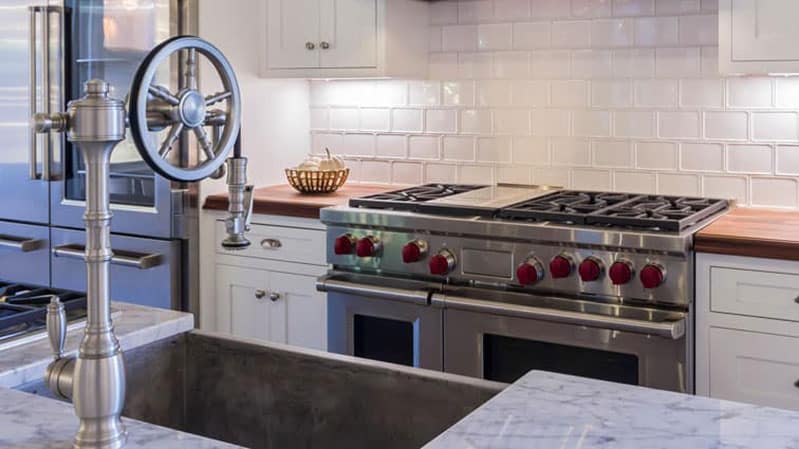
The convection conversion option on your wall oven or ranges is meant to take the guesswork from using this useful mode.
When you select the convection option, the displayed temperature may be different than the one programmed.
The oven will automatically convert the standard thermal baking time and temperature to an ideal time and temperature for convection cooking.
For example, if you typically program your oven to 350 F but use the convect convert option, the displayed temperature will read as 325 F.
Because the oven has already done the calculations for you and set the temperature, there is no reason not to use this mode.
How to Convert Your Recipes to Convection if You Don’t Have Convection Convert
We get a lot of questions about convection cooking and convection conversion.
There is a simple formula to follow, but some ranges and wall ovens come with the option that simply allows the appliance to do the calculations for you.
This may sound confusing, but the method is very simple and worth understanding for more efficient and time-saving results.
Converting your recipes using the standard convection formula is easy. Typically we recommend the 25/25 rule.
This means the oven temperature should be programmed 25 degrees less than the given cooking time, and the food should cook in 25% less time.
You will see a slight difference in time for things like cookies or other small baked items. The real impact on time-saving with convection is for larger roasted meats or dense vegetables.
In addition to your food cooking faster, the other benefit of using convection is getting a nice all-around color from top to bottom and side to side.
Without convection, you must factor in the process of rotating your pans and spinning them in the oven to get color all around.
This becomes more labor-intensive and keeps you tied to the oven for the duration of your cooking time.
In Summary: If your wall oven or range offers the convect convert option, don’t be afraid to use it.
If you are worried about overcooking or burning your food, be more conservative with your cooking times and periodically check on the doneness of your food.
Once you have mastered the Convert setting, you can set your oven on your own and calculate the cooking times based on the simple 25/25 rule.
Should You Buy a Convection Oven?
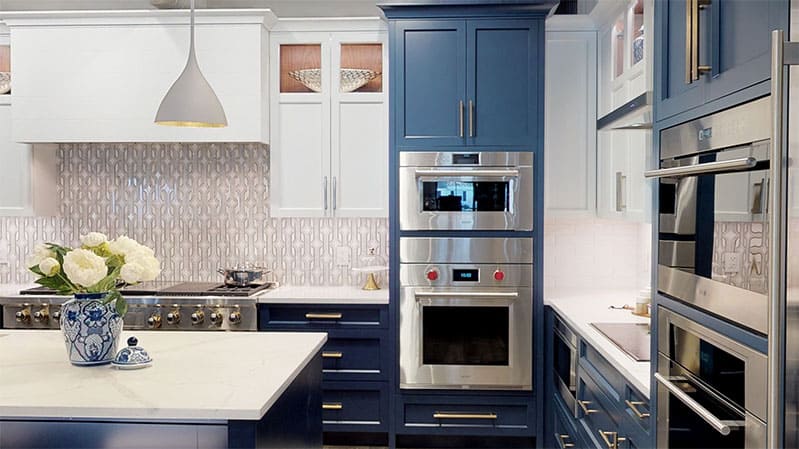
As for recommendations, with any type of convection, you can't go wrong. It just depends on the level of precision you want.
If you tend to do a lot of roasting of proteins and vegetables, a single convection fan, whether True convection or not, most often will suffice.
If you bake a lot, then consider a True convection system.
The dry heat from an electric oven will yield better baking results. As for True convection with dual fans, I like the vertically placed fans. I feel they can cook more evenly throughout.
Additional Resources
Confused about Wall Ovens? Get the Yale Wall Oven Buying Guide with updated features, specs, and detailed profiles of the best brands like Miele, Wolf, Viking, Bosch, Thermador, and more. Over 680,000 people have read a Yale Guide.
Related Articles
Why Should You Trust Us?
It seems that every appliance review has nothing but glowing comments about almost every product, yet you read customer reviews and they are almost universally bad.
We are here to fill in the disconnect. We'll give you the best features, and the drawbacks as well, including reliability based on over 37,000 calls performed by our service team just last year. Our goal is to give you ALL the information so you know what's right for you.
Please consider subscribing or adding to the conversation in the comments below. We appreciate you stopping by.
Saba is the resident Chef at Yale. She will teach you how to use your new oven, cooktop, or range. She is skilled in every new feature, including steam, induction, convection of all types, air frying, and sous vide. Saba is also the reigning Chopped Grand Champion crowned by Martha Stewart herself. Saba is incredibly versatile with all different types of cuisine. After just one session with her, you will be a better chef.
Saba has also been featured in numerous publications such as
Mashed,
Eater Boston, the
Boston Herald, and the
Framingham SOURCE.
A Note About Pricing
Pricing on this blog is for reference only and may include time sensitive rebates. We make every attempt to provide accurate pricing at time of publishing. Please call the stores for most accurate price.
Topics:
